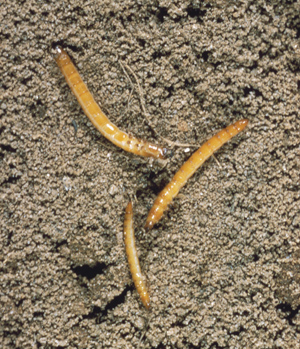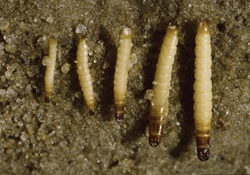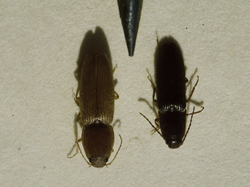
Features
Chemicals
Insects
Eye on Potatoes: Managing wireworms in potatoes
The search is on in New Brunswick potato fields for wire
March 12, 2008 By Marg Land
The search is on in New Brunswick potato fields for wireworm
samples. The worms, which are the larval stage of click beetles, are a major
pest of potato production in Canada and can easily ravage potato crops
 |
| Wireworms hibernate in the soil at depths anywhere between five and 25 cm and rise to the surface as click beetles in the spring. Photo courtesy of R.J. Reynolds Tobacco Company Slide Set, R.J. Reynolds Tobacco Company; Bugwood.org |
The search is on in New Brunswick potato fields for wireworm
samples.
The worms, which are the larval stage of click beetles, are a major pest of potato production in Canada and can easily ravage potato crops, especially fields that have recently been put into production.
Bob Vernon, a research scientist with Agriculture and Agri-Food Canada’s Agassiz, B.C., office, explains that click beetles lay eggs in the soil and the larvae, or wireworms, develop in soil over several years – between three and six years – depending on the species. Their favourite habitat is grassland or pasture where populations can build up to enormous levels, like a million per acre, over time. When that pasture is replaced with another crop, such as potatoes, the wireworms left behind in the soil can cause severe damage for several years.
 |
| Wireworms, which are the larval stage of click beetles, are a major pest of potato production in Canada and can easily ravage potato crops, especially fields that have recently been put into production. Photo courtesy of Steve L. Brown, University of Georgia; Bugwood.org |
Vernon said no samples of wireworm were found in New Brunswick in 2006 despite traps being out; however, there have been cases in recent years where wireworm has destroyed 100 per cent of a potato field and caused damage to other crops. Wireworm has become a major insect pest of potatoes in both British Columbia and the Maritimes. Two species from Europe, the Agriotes obscurus and A. lineatus, are species causing major problems.
More traps will be in the N.B. fields during the 2007 growing season and Vernon is asking producers to be on the watch for the pest. If growers discover wireworms, they are asked to collect a sample and put it in an empty container, along with some soil, and contact Vernon at vernonbs@em.agr.ca. He will direct growers on how to mail the package. He hopes this work will help researchers determine the location of the pests and |the species of wireworm living in the affected area.
 |
| Wireworms, a major pest in potato production within British Columbia and the Maritimes, are actually the larval stage of the click beetle. Photo courtesy of Steve L. Brown, University of Georgia; Bugwood.org |
Wireworms hibernate in the soil at depths anywhere between five to 25 centimetres, explains Vernon, adding that they rise to the surface as click beetles in the spring. Females like to lay eggs in loose soil and once the larvae hatch, they begin feeding on the roots of the just-planted field.
He recommends growers not leave potato fields fallow over the summer and use spring cultivation as a way of disrupting, starving and damaging the wireworms.
Print this page